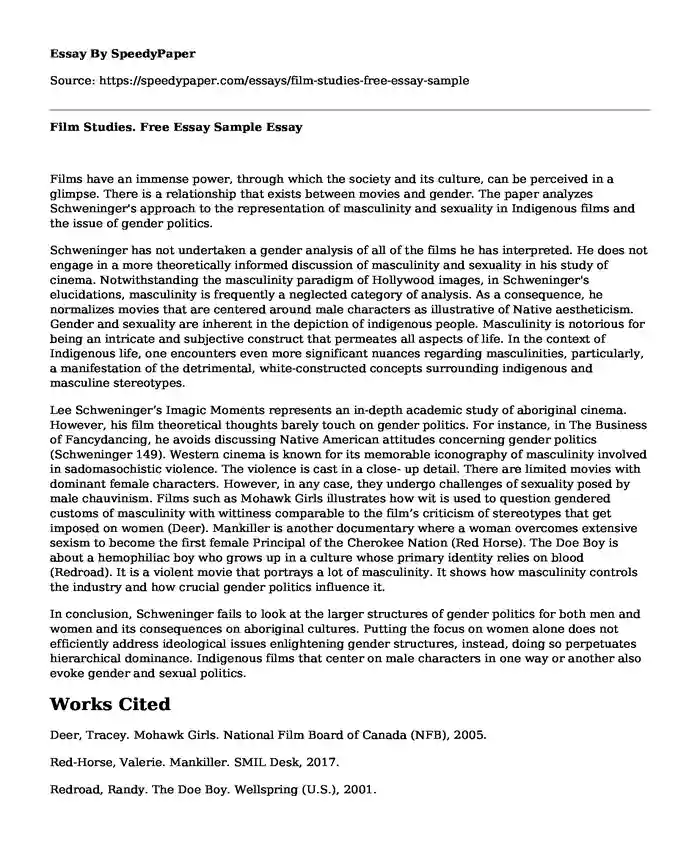
| Essay type: | Critical analysis essays |
| Categories: | Gender Culture Inspiration Movie |
| Pages: | 2 |
| Wordcount: | 458 words |
Films have an immense power, through which the society and its culture, can be perceived in a glimpse. There is a relationship that exists between movies and gender. The paper analyzes Schweninger's approach to the representation of masculinity and sexuality in Indigenous films and the issue of gender politics.
Schweninger has not undertaken a gender analysis of all of the films he has interpreted. He does not engage in a more theoretically informed discussion of masculinity and sexuality in his study of cinema. Notwithstanding the masculinity paradigm of Hollywood images, in Schweninger's elucidations, masculinity is frequently a neglected category of analysis. As a consequence, he normalizes movies that are centered around male characters as illustrative of Native aestheticism. Gender and sexuality are inherent in the depiction of indigenous people. Masculinity is notorious for being an intricate and subjective construct that permeates all aspects of life. In the context of Indigenous life, one encounters even more significant nuances regarding masculinities, particularly, a manifestation of the detrimental, white-constructed concepts surrounding indigenous and masculine stereotypes.
Lee Schweninger’s Imagic Moments represents an in-depth academic study of aboriginal cinema. However, his film theoretical thoughts barely touch on gender politics. For instance, in The Business of Fancydancing, he avoids discussing Native American attitudes concerning gender politics (Schweninger 149). Western cinema is known for its memorable iconography of masculinity involved in sadomasochistic violence. The violence is cast in a close- up detail. There are limited movies with dominant female characters. However, in any case, they undergo challenges of sexuality posed by male chauvinism. Films such as Mohawk Girls illustrates how wit is used to question gendered customs of masculinity with wittiness comparable to the film’s criticism of stereotypes that get imposed on women (Deer). Mankiller is another documentary where a woman overcomes extensive sexism to become the first female Principal of the Cherokee Nation (Red Horse). The Doe Boy is about a hemophiliac boy who grows up in a culture whose primary identity relies on blood (Redroad). It is a violent movie that portrays a lot of masculinity. It shows how masculinity controls the industry and how crucial gender politics influence it.
In conclusion, Schweninger fails to look at the larger structures of gender politics for both men and women and its consequences on aboriginal cultures. Putting the focus on women alone does not efficiently address ideological issues enlightening gender structures, instead, doing so perpetuates hierarchical dominance. Indigenous films that center on male characters in one way or another also evoke gender and sexual politics.
Works Cited
Deer, Tracey. Mohawk Girls. National Film Board of Canada (NFB), 2005.
Red-Horse, Valerie. Mankiller. SMIL Desk, 2017.
Redroad, Randy. The Doe Boy. Wellspring (U.S.), 2001.
Schweninger, Lee. Imagic Moments: Indigenous North American Film. University of Georgia Press, 2013.
Cite this page
Film Studies. Free Essay Sample. (2023, Aug 21). Retrieved from https://speedypaper.com/essays/film-studies-free-essay-sample
Request Removal
If you are the original author of this essay and no longer wish to have it published on the SpeedyPaper website, please click below to request its removal:
- GLYCEMIA IN A KUWAITI POPULATION
- Essay Example on Terrorism and Islamic Charities
- Gender Roles Established in Television - Free Essay for Everyone
- Free Essay Describing the Detrimental of Donald Trump's Presidency to the US
- The Gender Pay Gap - Free Essay for Everyone
- Essay Sample Defining Organizational Psychology and Leadership
- Paper Example. Social Media Surveillance
Popular categories




